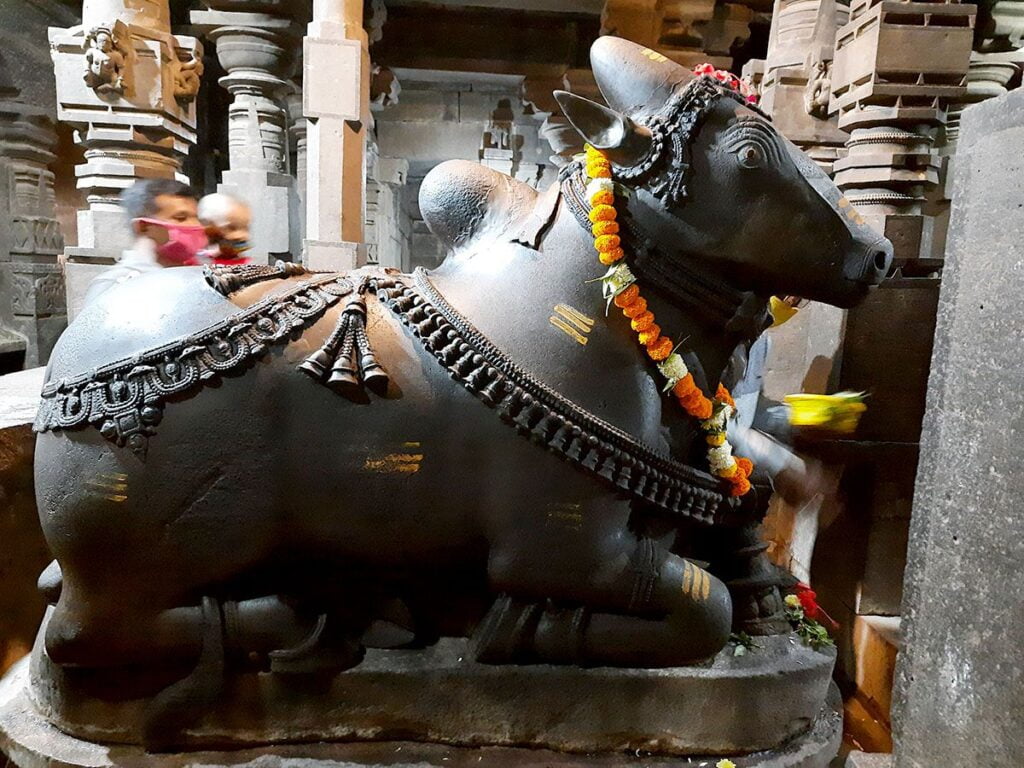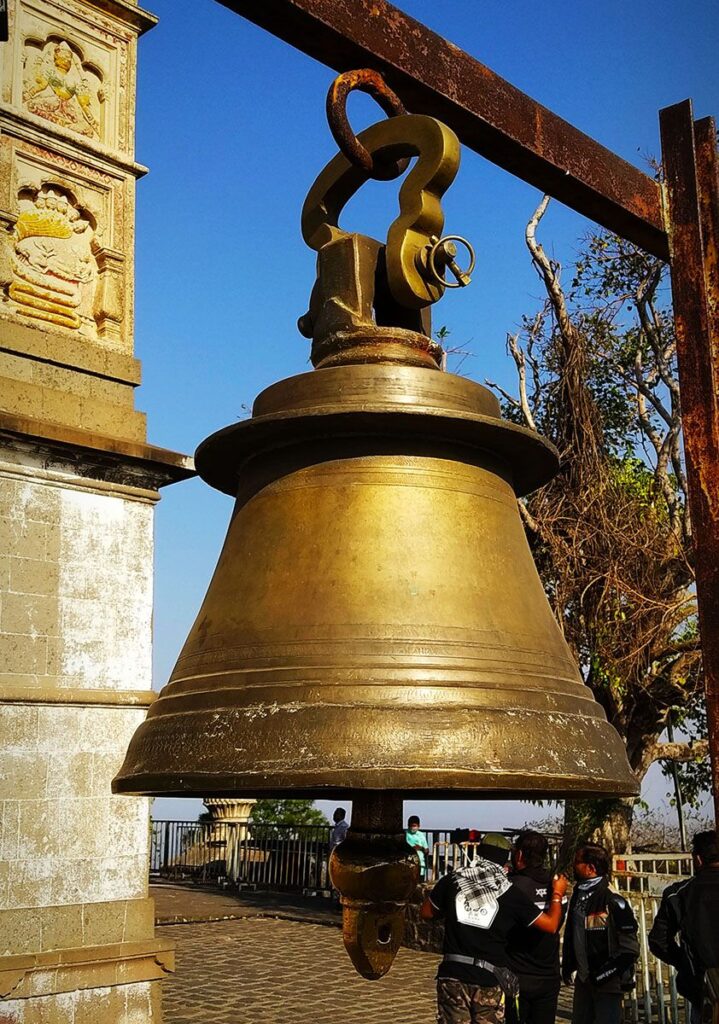Bhuleshwar Temple: 8 CE Shiva Abode in Islamic Garb
The Bhuleshwar Temple is an ancient Hindu temple dedicated to Lord Shiva, situated around 45 kilometers from Pune and 10 kilometers from Pune Solapur highway from Yawat in Maharashtra, India. The temple is perched on a hill and is believed to have been built sometime in the 8th century.

Contents
Bhuleshwar Temple History:
- Construction and History:
- The temple was built in the 13th century during the Yadava rulers’ period.
- It is believed that the temple was originally a fort called Mangalgadh or Daulatmangal Fort.
- The temple figurines were attacked and disfigured by the Mughals during their reign.
- Folk Tale:
- The temple is situated on a hill and offers classical carvings on its walls.
- The composition of light within the temple is an interesting phenomenon, especially for artists and photographers.
- The temple has an idol of Ganesha in female attire, known as Ganeshwari, Lambodari, or Ganeshyani.
- Location and Surroundings:
- The temple is located on the Daulatmangal fort, also known as Mangalgad.
- The fort was constructed in 1629 by Adilshahi general Murar Jagdev Pandit to keep watch over Pune after he looted the city.
- Many tourists visit the temple and the historical sites around it.
- Bird-watchers also frequent the area, as many birds migrate to nearby places during summer.
Read More>> Kailashnath Temple: Kailasa Temple Mystery at Ellora Caves

Legend of Bhuleshwar Temple:
- Shiva’s Meditation and Parvati’s Dance: According to the legend, Lord Shiva came to the Bhuleshwar site to meditate. Wanting to reunite with him, Goddess Parvati disguised herself as a tribal woman and performed captivating dances to win back his attention. The word “Bhul” in Marathi means “to forget” or “to be charmed,” and the legend suggests Shiva was charmed out of his meditation by Parvati’s beauty.
- Reunion and Temple’s Name: Entranced by Parvati’s dance, Shiva is said to have been drawn back to her. The place where this celestial performance occurred is believed to be where the Bhuleshwar temple stands today. The temple’s name itself reflects this legendary story, with “Bhuleshwar” translating to “Lord Shiva who was charmed.”
Read More>> Vajreshwari Temple Maharashtra
Significance of Bhuleshwar Temple:
- Historical Significance:
- Built in the 13th century by the Yadava rulers [Maharashtra Bhraman], it’s an ancient temple dedicated to Lord Shiva.
- The temple is built on a hill and was part of a fort called Mangalgadh [Maharashtra Bhraman]. It’s believed invaders might have damaged it, and the entrance was later hidden for protection.
- It’s now a protected monument under the Archaeological Survey of India.
- Mythological Significance:
- Legend says Devi Parvati danced for Lord Shiva here, and then they went to Mount Kailash and got married.
- The temple is associated with a folk tale of sweets offered to the Shiva Ling disappearing.
- It houses an idol of Ganesha in female form, known as Ganeshwari or Lambodari.
Read More>> Shani Shingnapur: Only Village With no Doors to Houses

Myths of Bhuleshwar Temple:
- Parvati’s Dance: One popular myth tells the story of Parvati, the consort of Lord Shiva. In this tale, Parvati performed a captivating dance here to win over Shiva, who appeared before her as Bhuleshwar or Bhola (the simple one). It’s believed this is where they began their journey towards marriage on Mount Kailash.
- Disappearing Sweets: Another well-known folktale is about the offerings made to the Shiva Linga (representation of Shiva) in the temple. Devotees believe that when they offer a bowl of sweets (pedhas) to the Shivalinga, one or more candies mysteriously disappear. This is seen as a sign of Lord Bhuleshwar accepting the offering.
Read More>> Titwala Ganesh Mandir: Where Devotion Meets Serenity
Bhuleshwar Temple Architecture:
Hemadpanthi style with Islamic influences:
- The temple is primarily built in the Hemadpanthi style, named after the Yadava king Hemadri who popularized it.
- This style uses black basalt stone, evident in the Bhuleshwar temple’s structure.
- Uniquely, the exterior has elements resembling Islamic architecture, particularly a dome and a structure mistaken for minarets.
Theories behind the Islamic facade:
- There’s a local legend that the temple’s exterior design was a deliberate attempt to camouflage it from invaders during a period of iconoclasm.
- By appearing like a mosque, the theory goes, the temple was spared destruction.
Intricate carvings and traditional layout:
- Despite the exterior facade, the Bhuleshwar temple adheres to a traditional Hindu temple layout.
- This includes a Nandi mandapa (pavilion for the statue of Nandi, the bull vehicle of Shiva), a sabha mandapa (main hall), an antarala (antechamber), and a garbhagriha (shrine).
- The temple walls are adorned with intricate carvings depicting deities, mythological characters, geometric patterns, and scenes from Hindu mythology.
Read More>> Mahabaleshwar Temple Maharashtra: 1200 yrs Sacred Atmalinga

Bhuleshwar Temple Timing and Rituals:
Timing:
According to some sources, the temple is open daily from 5 AM to 9 PM. Devotees can witness rituals of Lord Shiva being performed during this time. However, the ideal time to visit is said to be between 6 AM to 12 PM and 4 PM to 8 PM.
Rituals:
- Abhisheka: This involves bathing the Shiva linga (the idol) with holy water, milk, curd, ghee, and other offerings.
- Aarti: Aarti involves lighting lamps or wicks filled with ghee or oil near the deity while chanting mantras.
- Bhasma Aarti: In some Shiva temples, especially in South India, aarti is performed with sacred ash (bhasma).
- Rudrabhishek: This is an elaborate abhisheka with 11 different substances.
Read More>> Shirdi Sai Baba Temple Maharashtra

Places to visit near Bhuleshwar Temple:
- Purandar Fort: Situated around 30 kilometers from Bhuleshwar Temple, Purandar Fort is known for its historical significance and scenic views. It offers trekking opportunities and a chance to explore ancient architecture.
- Torna Fort: Also known as Prachandagad, Torna Fort is one of the tallest forts in Pune district. It’s about 50 kilometers from Bhuleshwar Temple and offers trekking trails, historical ruins, and panoramic views.
- Jejuri: Jejuri, located around 15 kilometers from Bhuleshwar Temple, is famous for the Khandoba Temple. This temple is renowned for its vibrant celebrations during festivals like Somvati Amavasya and Chaitra Pournima.
- Narayanpur: Narayanpur is a small village near Bhuleshwar known for its ancient temples, including the Narayaneshwar Temple and Rameshwar Temple. It’s a serene place with historical significance.
- Panshet Dam: Panshet Dam is approximately 60 kilometers from Bhuleshwar Temple. It’s a popular spot for picnics, boating, and water sports. The lush green surroundings and the reservoir offer a peaceful getaway from the city.
- Vetal Tekdi: Vetal Hill is a popular spot for hiking and nature walks, located within Pune city limits. It offers panoramic views of the city and is a great place for outdoor activities.
- Sinhagad Fort: Sinhagad Fort, situated around 50 kilometers from Bhuleshwar Temple, is another historical site known for its significance in Maratha history. It’s a popular destination for trekkers and history enthusiasts.
- Shaniwar Wada: Shaniwar Wada is a historical fortification located in Pune city, around 40 kilometers from Bhuleshwar Temple. It was the seat of the Peshwas of the Maratha Empire and is known for its architectural grandeur and historical importance.
FAQ:
- What is Bhuleshwar Temple?Bhuleshwar Temple is an ancient Hindu temple dedicated to Lord Shiva. It is located near Pune, Maharashtra, India.
- What is the significance of Bhuleshwar Temple?Bhuleshwar Temple is renowned for its unique architecture and historical significance. It is believed to have been built during the Yadava dynasty and holds immense religious importance for devotees of Lord Shiva.
- Where is Bhuleshwar Temple located? This temple is situated in the village of Yavat, approximately 50 kilometers from Pune city, in the Pune district of Maharashtra, India.
- What is the architecture of Bhuleshwar Temple like?The architecture of the Temple is characterized by its ancient stone carvings, intricate designs, and unique structural elements. The temple’s exterior features intricate carvings of various Hindu deities, while the interior houses the sanctum sanctorum of Lord Shiva.
- What are the festivals celebrated at Bhuleshwar Temple?The temple celebrates major Hindu festivals such as Maha Shivaratri, Gudi Padwa, and Navratri with great fervor and devotion. These festivals attract a large number of devotees from various parts of India.
- Is there any historical significance associated with Bhuleshwar Temple?Yes, the Temple is believed to have been constructed during the Yadava dynasty, making it an important historical site. It is also said to have been a place of refuge for the Pandavas during their exile period from the Mahabharata.
- Is there any legend associated with Bhuleshwar Temple?According to local legend, Goddess Parvati danced at this site to appease Lord Shiva, leading to the temple’s construction. Hence, the temple is also known for its association with the divine dance of Parvati.
- Is there any accommodation available near Bhuleshwar Temple?Yes, there are several guesthouses and hotels available in nearby towns like Pune, Yavat, and Daund, providing accommodation options for pilgrims and tourists visiting the Temple.
- Are there any nearby attractions to visit along with Bhuleshwar Temple?Yes, visitors can explore other nearby attractions such as the historic forts of Lohagad and Visapur, the ancient caves of Karla and Bhaja, and the scenic beauty of the Sahyadri mountain range.
- What are the visiting hours of Bhuleshwar Temple? The Temple is usually open to devotees and tourists from early morning to late evening. However, it’s advisable to check the exact visiting hours locally or online before planning your visit.
- How many steps are there in Bhuleshwar Temple?
- An uphill Bhuleshwar Temple trek of approximately 200 odd steps takes you to the main temple.
- Who built the Bhuleshwar Temple?
- According to Hindu mythology, the temple was built by the Panch Pandava.
- Additionally, another temple dedicated to King Bharata was constructed at Bhartgaon, near the Bhuleshwar temple.
How to reach Bhuleshwar Temple:
- By Car/Taxi: You can hire a taxi or drive your own car to reach Bhuleshwar Temple. The temple is well-connected by roads, and you can follow directions on GPS or ask locals for guidance.
- By Bus: Public buses operate from Pune to Yawat, which is the nearest town to Bhuleshwar Temple. From Yawat, you can either hire a local transport or walk to the temple.
- By Train: The nearest railway station to Bhuleshwar Temple is Pune Junction. From Pune, you can either hire a taxi or take a bus to reach the temple.
- By Air: The nearest airport to Bhuleshwar Temple is Pune Airport. From the airport, you can hire a taxi or take a bus to reach the temple.

One Comment